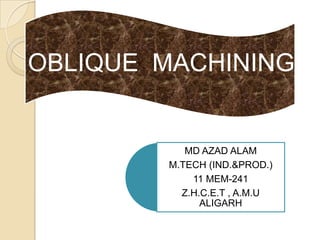
azad alam alig
- 1. OBLIQUE MACHINING MD AZAD ALAM M.TECH (IND.&PROD.) 11 MEM-241 Z.H.C.E.T , A.M.U ALIGARH
- 2. DESIGNING OF TRANSMISSION LINE Chapter-1 Selection of system design Chapter-2 Insulator design Chapter-3 Conductor Chapter-4 Mechanical design of transmission line Chapter-5 Tower design Chapter-6 Performance of transm
- 3. Chapter-1 Selection of system design Chapter-2 Insulator design Chapter-3 Conductor Chapter-4 Mechanical design of transmission line Chapter-5 Tower design Chapter-6 Performance of transmission line
- 4. Machining processes: Metals come in its usable form through various processes by machine tools. Machining processes remove material from a workpiece. CUTTING: ABRASIVE: NONTRADITIONAL:
- 5. Metal cutting: Metals cutting has thus become an indispensable to the modern industry.
- 7. METAL CUTTING 1. ORTHOGONAL CUTTING Tool is perpendicular to the cutting speed direction. 2. OBLIQUE CUTTING Angle between the cutting edge and cutting velocity vector is different from 90 degree.
- 8. Fundamentals of Cutting Oblique Cutting. ◦ THREE DIMENTIONAL ◦ INCLINATION ANGLE Cutting Forces and Power. ◦ MACHINE TOOL SELECTION ◦ DYNAMOMETER ◦ MANY VARIABLES FRICTION CUTTING FLUIDS TOOL SHARPNESS PROCESS
- 9. Oblique cutting The majority of machining operations involve tool shapes that are three-dimensional, thus the cutting is oblique. Whereas in orthogonal cutting, the chip slides directly up the face of the tool, in oblique cutting, the chip is helical and at an angle i, called the inclination angle. Fig .(a) shows the schematic illustration of cutting with an oblique tool. Note the direction of chip movement. (b) Top view, showing the inclination angle, i. (c) Types of chips produced with tools at increasing inclination angles.
- 10. Chip Formation in Nonmetallic Materials Fig: a) cutting with an oblique tool b) Top view showing the inclination angle, i. c) Types of chips produced with different inclination
- 11. Types of chips produced in metal cutting
- 12. Oblique cutting Note that the chip in Fig.(a) flows up the rake face of the tool at angle (chip flow angle), which is measured in the plane of the tool face. Angle αi is the normal rake angle, and it is a basic geometric property of the tool. This is the angle between line oz normal to the workpiece surface and line oa on the tool face. The effective rake angle, αe is 1 e sin sin 2 i cos 2 i sin i
- 13. Mechanism of Oblique Cutting The cutting edge is at an angle i, called inclination angle. The chip movement is in lateral direction Fig: a)right hand cutting tool.Although these tools have traditionally been produced from solids tool-steel bars,they have been largely replaced by carbide or other inserts of various shapes and sizes,as shownin b).The vcarious angles on these tools and their effects on machining are described
- 14. Oblique cutting Fig.(a) shows the schematic illustration of a right-hand cutting tool. The various angles on these tools and their effects on machining. Although these tools traditionally have been produced from solid tool-steel bars, they have been replaced largely with Fig 21.10(b) inserts made of carbides and other materials of various shapes and sizes.
- 15. DIRECTION OF CHIP FLOW Chip flow angle An important variable in oblique cutting & hence its determination. METHODS TO DETERMINE THE CHIP FLOW ANGLE. By observing the direction of scratches produced on the tool. By taking photographs of cutting process. By analyzing the deformation of chip. By analyzing the cutting forces.
- 16. RAKE ANGLES IN OBLIQUE CUTTING The different rake angles in oblique cutting . 1. Normal rake angle . 2. Velocity rake angle. 3. Effective rake angle.
- 17. REFRENCES Juneja ,B.L ; and G.S. Sekhon,Fundamentals of metal cutting and machine tools . ,Manufacturing science.
- 18. THANK YOU